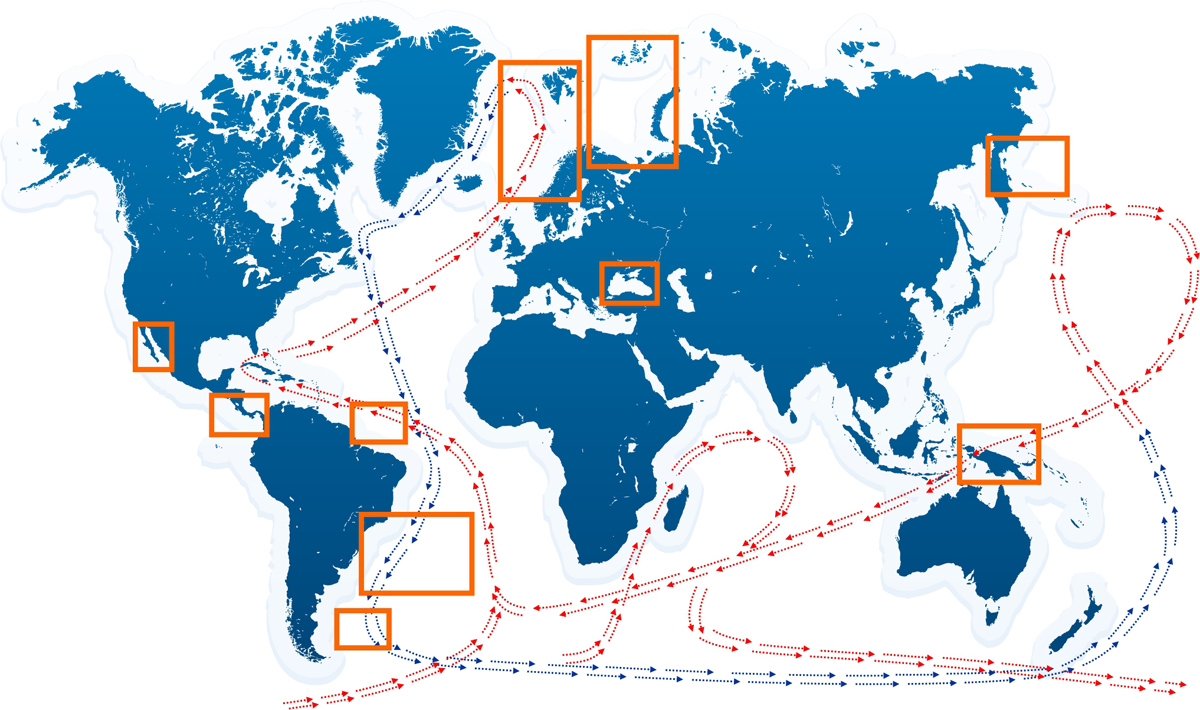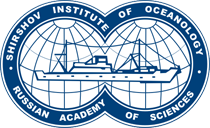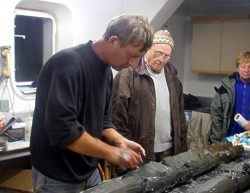MARINE GEOLOGY
Division Head Marina Kravchishina
Scientific Head Prof. Leopold Lobkovskiy, Academician of RAS
1970 Bathymetric map of the World ocean
1978 Theory of the phosphates formation in the upwelling zone
1987-2003 Hydrothermal systems and processes of mineralisation at a depth of 3-5 km researched
1993-2007 Concept of marginal filter, trapping the river runoff and pollution
2005 “Seismic gap” detected in the Kuril Islands and the potential sources of tsunami identified in the Sea of Okhotsk
2009 Gas hydrates field – a potential fuel source – is discovered on the Lake Baikal bed
2011 Geodynamic model of the Arctic evolution over the last 150 million years was a part of the rationale for the Russia’s UN submission on the outer Arctic shelf limits
In February 2016, the official submission of the application of the Russian Federation to the UN Commission
Children categories
Laboratory of Geodynamics, Georesources, Georisks and Geoecology
Head: Academician of RAS, Prof. Leopold Lobkovsky
Department of Geology and Geodynamics

The main directions of study:
Tectonics of deformable continental plates and regional geodynamics.
Structure of sedimentary basins and mineral resources of the World Ocean and marginal seas.
Stress-strained state of the lithosphere, seismicity and georisks.
Geoecological study of seas.
Geodynamic evolution of the Arctic and hazards on the Arctic shelf.
Laboratory of Dangerous Geological Processes
Head: Dr. Boris Baranov
Department of Geology and Geodynamics

The main directions of study:
Study of the Cenozoic geodynamics of the Arctic and Far Eastern regions and the development of geodynamic models of their key regions.
Study of georisk systems at the boundaries of the plates of the Arctic and Far Eastern regions.
Zenkovich Laboratory of the Sea Shelf and Coasts
Head: Prof. Sergey Kuznetsov
Department of Geology and Geodynamics

The main directions of study:
Hydro-, litho– and morphodynamic processes in shelf and coastal zones and sea coasts.
Experimental investigation of non-linear wave dynamics and processes of sand suspending and transport.
Particulate matter and pollutant fluxes in the shelf seas of the Russian Arctic.
Theoretical studies and numerical modeling of the coastal profile evolution on various time scales.
Shelf and coasts evolution in the Late Q and its forecast under climate change and sea level rise.
Geochemistry Laboratory
Head: Prof. Alexander Dubinin
Department of Geology and Geodynamics

The main directions of study:
Development of methodologies for the detection of rare and trace elements in the ocean, subsequent to their concentration in water and sulphide minerals, as indicators of ore deposits.
Rare elements in the ocean water and bottom sediments as indicators of ore formation.
Hydrochemistry and isotopic composition of S, C, O and H in the water of anaerobic marine basins.
Numerical modeling of biohydrochemical processes.
Geochemistry of sedimentation and ore formation in oceans and seas.
Soloviev Tsunami Laboratory
Head: Dr. Igor Medvedev
Department of Geology and Geodynamics

The main directions of study:
Tsunami effects on the Far East, Black and Caspian Sea coasts.
Paleotsunamis in Kamchatka and the Kuril Islands.
Numerical modeling of generation and propagation of tsunamis.
Tsunami from underwater landslides and weather phenomena.
Risk assessment for Russian coasts.
Physical distribution study of earthquakes in the Pacific.
Tsunami catalogues.
Geophysical Fields Laboratory
Head: Dr. Alexander Ivanenko
Department of Geomorphology, Geophysics and Biogeochemistry

The main directions of study:
Marine geoelectromagnetic data processing and geological interpretation.
Laboratory measurements of magnetic properties of mineral samples.
Models of the magnetic layer and conductivity of the Earth’s crust and upper mantle.
Seismostratigraphy Laboratory
Head: Prof. Sergey Nikiforov
Department of Geomorphology, Geophysics and Biogeochemistry

The main directions of study:
Geophysics and geomorphology of the seabed of the Arctic, inland and marginal seas of Russia, the Atlantic and Indian oceans.
Geological-geomorphological mapping and geomodeling of the relief of the bottom and sedimentary strata.
Fine structure of sedimentary strata and high-resolution seismic-acoustic measurements.
Complex fundamental and engineering geological and geophysical research.
Laboratory of Oil and Gas Content in Aquatories
Head: Dr. Alexander Egorov
Scientific Consultant: Academician Anatoliy Dmitrievskiy
Department of Geomorphology, Geophysics and Biogeochemistry

The main directions of study:
Fundamental issues of oil and gas formation and accumulation in the ocean floor.
Field surveys and theoretical studies of gas hydrates in aquatories. Appraisal of their reserves.
Water ands sediment testing for oil, gas and hydrate indicators using geochemical (gas) and bitumen methods.
Cataloguing oil and gas reserves in the World ocean and their extraction techniques.
Ocean Chemistry Laboratory
Head: Dr. Alexander Ulyantsev
Department of Geomorphology, Geophysics and Biogeochemistry

The main directions of study:
Chemistry and biogeochemistry of marine ecosystems.
Expert assessment of environmental conditions based on molecular markers including hydrocarbons, lignin, phenols, pesticides, and PAH.
Development of quantitative models of the cycles of organic substances in biosphere with focus on carbon cycle.
Improvement of system investigation of marine processes and development of fundamentals of marine organic geochemistry.
Lisitzin Laboratory of Physical and Geological Research
Head: Dr. Marina Kravchishina
Department of Modern and Ancient Sediments of the World Ocean

The main directions of study:
Sedimentation and geochemistry of the Arctic and the Atlantic Oceans and their seas.
Transeuropean meridian eco-geochemical section of the seas.
Methane cycle in the ocean.
Micro– and nano-particles in the World ocean as natural bioinert sorbent of heavy metals and hydrocarbon contamination.
Hydrothermal ore genesis in the ocean floor.
Analytical Laboratory
Head: Dr. Aleksandr Novigatsky
Department of Modern and Ancient Sediments of the World Ocean

The main directions of study:
Natural and anthropogenic processes in aquatic areas, including in the remote parts of the World Ocean.
Analysis of aerosols, suspensions, soils, bottom sediments, rocks and ores.
IR spectrofotometer IRAffinity-1 (Shimadzu).
Diffractometer D8 ADVANCE (Bruker AXS GmbH).
Scanning electron microscope VEGA-3sem (TESCAN).
Paleoecology and Biostratigraphy Laboratory
Head: Prof. Alexandеr Matul
Department of Modern and Ancient Sediments of the World Ocean

The main directions of study:
Current distribution of marine microorganisms as reflection of environmental and biogeographical conditions.
Biostratigraphy and age detection of bottom sediments based on micropaleontology.
Reconstruction of environments and the ocean system in the geological past.
Paleoclimatic impact of the ocean on global changes.
Laboratory of Paleoceanology
Head: Prof. Elena Ivanova
Department of Modern and Ancient Sediments of the World Ocean

The main areas of research:
High-resolution paleoceanographic reconstructions in oceans and seas.
Quaternary sedimentation in the World Ocean.
Contourite systems and bottom-water circulation in the Atlantic during the Neogene-Quaternary time.
Global and regional correlations.
Mechanisms of climate change.
Climatic teleconnections.




